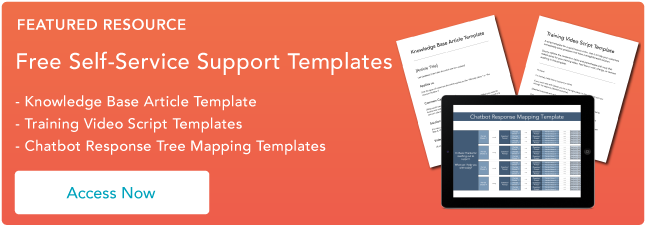Customers want to help themselves as much as possible and will turn to support reps only when they can't do so. So, it makes sense to provide them with the appropriate resources to help them accomplish this goal.
In fact,53% of U.S. online adultswill most likely abandon their online order if they can't find a quick answer to their question on their own. No offense, but customers would rather search their question and get an immediate solution than pick up the phone and have to wait on hold just to speak to a rep and ask them the same simple question.
Enter your知识库.
Knowledge Base Definition
A knowledge base is a centralized database for spreading information and data. Knowledge bases support collecting, organizing, retrieving, and sharing knowledge.
There are two main forms of knowledge bases: machine-readable and human-readable.
Machine-readable knowledge bases store data that can only be analyzed by artificial intelligence systems. These solutions are interpreted and deducted by machines and, thus, are less interactive. Human-readable knowledge bases store documents and physical texts that can be accessed by humans. They are more interactive and hands-on but require time-consuming prompting to gain solutions.
A company's knowledge base can provide valuable information to customers and prospects. For instance, you may include knowledge on each department, directions and tips for using your products and services, FAQs, and content you've created that can provide in-depth solutions.
Why You Need a Knowledge Base
1. It's faster for your customers.
People no longer have the patience to flip through dusty encyclopedias in public libraries. They want answers, and they want them now. If a customer or prospect has a specific question about your company -- whether it be "What is artificial intelligence?" or "How do I apply for a job?" -- they'll assume they can simply search that question or similar keywords on your website and be bombarded with tons of answers.
2. It's helpful for your reps.
In addition, your support team can only handle so much. Increasingly, customer support teams have more responsibilities that are separate from directly answering customer questions via phone, email, and live chat. By providing a helpful knowledge base, your customers can get the answers they need on their own. This frees up your support reps to handle more important issues and allows your customers to feel accomplished that they found a solution all by themselves -- after all, in 2015,81% of online U.S. adultsused knowledge bases and FAQ pages.
3.很容易build.
If you can't provide immediate knowledge to your customers, they will turn to a competitor who can. It can be tough to create and manage a knowledge base. However, it can start off easily -- think about the kinds of questions you've had customers ask you in the past and, maybe, the questions you've searched yourself. You can analyze common tickets to determine which issues crop up most frequently that you need to address first. Slowly, your team can build an informative knowledge base that can be a constant resource.
Examples of Knowledge Bases
1. Lyft


Source:Lyft
Lyft goes above and beyond by providing a knowledge base specifically for drivers. Rather than just structuring it as a search bar that comes up with keyword-based solutions, Lyft has pre-written tons of brief blog posts that provide valuable advice to drivers, such as "Rowdy Passenger? Here’s How to Let Us Know" and "Pop Quiz: Can We Pick up Street Hails?"
The titles are grabby and the information is condensed into a few, short paragraphs -- perfect for a busy driver on the go. In addition, Lyft even has a separate knowledge base specifically for riders. By separating based on user demographics, it makes the information all the more accessible and relevant.
2. Canva


Source:Canva
画布页面有一个美观的支持, clean-cut layout that makes finding appropriate tools simple and quick. There are some featured articles that are based off FAQs, but the best part is the drop-down menu on the left. Each parent category has child categories, and each of those has even more child categories that help you find a resource as specific to your issue as possible.
For instance, clicking on "Canva for iPhone" leads to several more categories. I could then click on "Photos for iPhone" and, finally, get to the root problem, which is "Change photos to solid colors (iPhone)." The easier your knowledge base is, the fewer customers will be emailing or calling you about these quick fixes.
3.HubSpot Academy
Source:HubSpot Academy
HubSpot Academy -- HubSpot's resource that provides free tools and training to help businesses and individuals grow -- has a Help section that provides tons of knowledge to readers. Some of the available resources are user guides, quick answer documents, HubSpot user groups, and community discussions. For instance, the above Quick Answers page covers a variety of questions that are categorized neatly for readers to locate.
What leverages Academy is its video, software, and classroom trainings, as well as its informative marketing, sales, and software certifications. Academy not only provides users with answers to their questions but helps train them so that they can then spread the same valuable information to others. In addition, it provides a User Blog to spread interesting and helpful content.
Now that you know why you need one, read this next post onhow to create a knowledge base.
Originally published Aug 14, 2018 7:00:00 AM, updated April 17 2020
Topics:
Knowledge BaseDon't forget to share this post!
Related Articles

Expand Offer
Customer Service Metrics Calculator
Get it now


